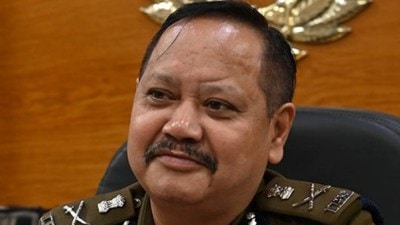Naresh Tikait, president of the Bharatiya Kisan Union (BKU), announced on Sunday (January 16) that the farmers’ union would support the candidates of the Samajwadi Party (SP) and Rashtriya Lok Dal (RLD) in the Uttar Pradesh Assembly elections.
Following a meeting with BJP leader Sanjeev Balyan on Monday, however, Naresh did an about-turn, declaring that the BKU would not support any party. Earlier in the day, Naresh’s younger brother Rakesh Tikait, spokesperson of the BKU, was quoted as having denied Naresh’s earlier statement. Rakesh underlined the non-partisan nature of the farmers’ union.

Earlier in December, Rakesh had ruled out contesting the election himself, after SP chief Akhilesh Yadav said that the farmer leader was welcome to fight on an SP ticket.
Story continues below this ad
Jat farmers, especially in western UP, are a politically powerful group, and are very important to determining election outcomes in a large number of seats in the region. A look at the BKU and its political history:
Birth of the BKU
The genesis of the BKU was in the early days of the Punjab Khetibari Union of the 1970s. The farmer leader Chaudhary Charan Singh, who served as the fifth Prime Minister of the country, is credited with raising the profile of the farmers’ union to the national level in the late 1970s.
Further consolidation of the farmers’ movement happened in 1980, when the iconic farmer leader from Tamil Nadu, C Narayanaswamy Naidu, called a meeting of major farmers’ movements in the country. As an outcome of the meeting, the All India Kisan Sammelan was organised, which saw the coming together of all farmers’ unions under one umbrella.
This union was, however, dissolved in 1982, as Narayanaswami’s BKU(N) and Bhupinder Singh Mann’s BKU(M) went their separate ways. The Maharashtra farm leader Sharad Joshi acted as a mediator, and a broad operational compromise was hammered out among the different unions as they worked separately in their states.
Story continues below this ad
The BKU started to gain importance and influence after Mahendra Singh Tikait reorganized the union in 1986, and moved its headquarters to Sisauli in Uttar Pradesh. Tikait, who was the head of the Baliyan Khap, decided to break from the policy of Charan Singh and chart a non-partisan course for the farmers’ movement.
BKU’s leap into prominence
Maharashtra’s veteran farmer leader Vijay Jawandhiya, who had had a long association with Sharad Joshi and his movement, said Tikait was helped in his early days by Choudhary Devi Lal from Haryana. Both Tikait and Devi Lal were based closer to the national capital geographically than Joshi or M D Nanjundaswamy, the leader of Karnataka’s Rayathu Sangh.
Tikait caught national attention when he led a 25-day gherao of the Meerut Commissioner’s office. He then led over 8 lakh farmers from Western Uttar Pradesh and other parts of the country to the famous sit-in at New Delhi’s Boat Club lawns over issues like the implementation of price control of cane, loan waivers, and traffic reconstruction for electric supply to farms.
Story continues below this ad
But again, following a public falling out between Joshi and Tikait, the BKU charted his own path, mostly in Uttar Pradesh.
The BKU and politics
The BKU being based in the sugarcane belt of Western Uttar Pradesh, Tikait’s agitation too was centred mainly around this crop and its farmers, Jawandhiya said.
The Punjab unit of the BKU had by then undergone several splits, with leaders like Mann, Balwinder Singh Rajewal, Ajmer Singh Lakhowal, and other leaders leading their own factions.
Story continues below this ad
“Some of the left-leaning farm leaders also led their own unions, which had substantial numbers of followers,” Jawandhiya said.

The BKU got support from politicians cutting across party lines, even as it maintained its non-partisan stance. But the farmers’ movement in general failed to become a political force with weight, Jawandhiya said.
Rakesh Tikait contested the Assembly election of 2007 with the support of the Congress, but failed to make a mark. In 2014, he entered the race for Lok Sabha on an RLD ticket, but ended up getting fewer than 10,000 votes in the Modi wave.
“Both Tikait and the family of Charan Singh are from the Jat community. The average Jat farmer politically follows Charan Singh and not Tikait, who they follow during agitations. The BKU would not like to openly cross swords with the RLD,” Jawandhiya said.
Story continues below this ad
Unlike Sharad Joshi in Maharashtra, Tikait has been a strong critic of the free market and of economic liberalization. In this regard, the position of the BKU is similar to that of Nanjundaswamy’s group.
Newsletter | Click to get the day’s best explainers in your inbox









































